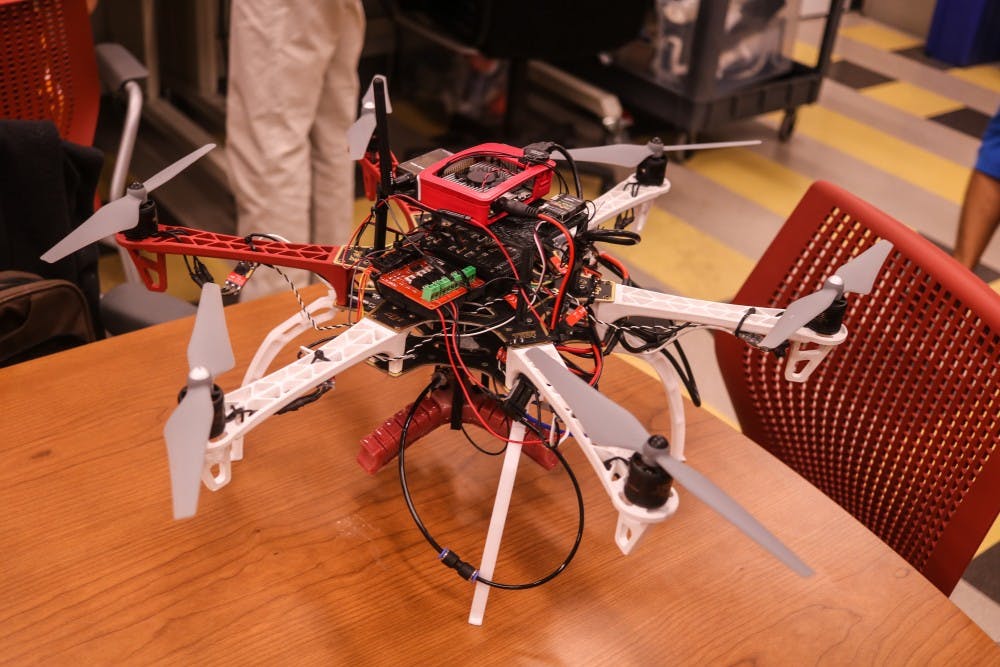ASU is currently developing a drone in collaboration with the Salt River Project to help collect water samples and contaminants from remote canal locations.
Currently, the Phoenix metro area has 180 miles of water canals, many of which are located in large stretches of desert or nestled tight into metropolitan areas.
Wenlong Zhang, assistant professor at the Polytechnic campus and one of the two leads on the project, said the project started more than a year ago when SRP held a meeting where it requested a more accessible and inexpensive way to collect water samples in isolated areas.
"The idea came from a discussion with SRP engineers about how can we help ensure the water quality for the entire Phoenix metro area," Zhang said. "Right now, the way that they have to do this is essentially to send their crews all the way to these canals ... so we proposed a vehicle equipped with a grasping mechanism that can take the samples and bring it back to their headquarters for analysis."
This vehicle ended up being a hexacopter, a drone with six rotors, which was built from the bottom up to SRP's specifications, to fulfill its tasks autonomously and be easily controlled.
"Consumer drones are not really tailored for (SRP's) needs in terms of payload, in terms of battery life and in terms of how distant it can travel," Zhang said. "The other challenge came from attempting to create a very intuitive accessible interface for SRP operators, so they can easily just operate the whole system on an iPad or on a computer screen."
Mike Ploughe, senior scientist at SRP, said ASU was chosen for this project over other universities due to its pre-existing partnership and previous projects.
"SRP and ASU have a long history of working multiple different projects for many different areas throughout our company, so we already have a lot of faith in the teams currently working on the Polytechnic campus," Ploughe said. "The drone is actually one of two current projects being developed that help us test water quality – the other being a submersible – but the drone will have other applications as-well."
Shatadal Mishra, a graduate student at the Ira A. Fulton Schools of Engineering and controls lead, said the two most important aspects of the drone are its soft robotic grasper, developed by Panos Polygerinos, Bio-Inspired Mechatronics Lab director, and its camera that is used to send images back to SRP headquarters.
"The grasper is actually derived from the soft robotic exoskeleton Professor Polygerinos is currently developing, it's designed to mimic the human hand and be form-fit to pick up objects carefully and precisely," Mishra said. "The hexacopter is also equipped with a camera, so let's say you upload an image of a certain object you want it to collect. The hexacopter will scan for the object and take pictures of what it thinks you might be looking for, it will then send these images back to headquarters and the user can choose what object they would like it to retrieve."
Ploughe said that he would like to see the technology being developed on both the drone and submersible go hand-in-hand, specifically integrating and adapting the drone's sensory technology onto the submersible to work underwater.
In regard to the difficulties the team has faced so far, Mishra said that one of the key factors of the drone's success, stability, is also one of their biggest challenges.
"FAA-mandated hexacopters are inherently unstable, and you need it to be stable so that it can preform its various tasks such as aerial photography and post-disaster area scans," Mishra said. "So we work on the algorithm aspect and also on the hardware to make sure that this can fly safely, robustly and more importantly this can fly on its own."
Although the drone has proven its ability to function properly, Zhang said there are still many months of development ahead. In that time he would like to see overall improvements made to the distance the drone can travel, its battery life, crash avoidance and the ability to land on water.
When it comes to the work his team is doing, Zhang said he prefers when his students work on projects like this as opposed to classwork, because he believes it better prepares them for work in industry.
"When they graduate, they're already equipped with a skill set that future employers would like to see, and that's because of the partnerships ASU has built and the opportunities they present us," Zhang said.
Reach the reporter at amville8@asu.edu or follow @AustinMVillegas on Twitter.
Like State Press on Facebook and follow @statepress on Twitter.




